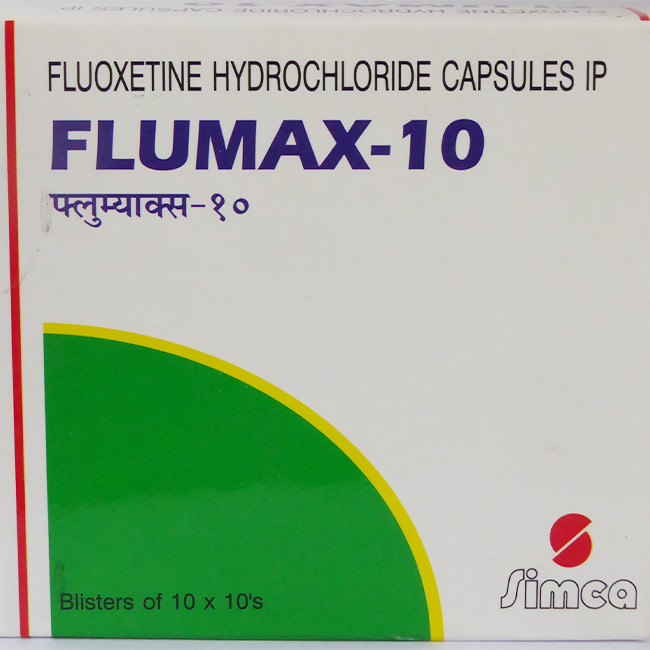Flumax
Generic composition: Fluoxetine
General description
Flumax is a second generation anti-depressants which is categorized as a selective serotonin reuptake inhibitor (SSRIs)
Therapeutic group
- Anti-depressants
Dosage forms available
- FLUMAX 10mg capsules
- FLUMAX 20mg capsules
Uses
- Major Depressive Disorder (MDD)
- Obsessive–compulsive disorder(OCD)
- Bulimia nervosa
- Panic disorder
- Premenstrual dysphoric disorder
- Also been used inpremature ejaculation
Dose
| Condition | Adult | Pediatric (>8 yrs) |
| MDD | 20 mg/ day initial in morning | 10-20 mg/day |
| OCD | 20 mg/ day initial in morning | 10 mg/day initial |
| Bulimia Nervosa | 60 mg/day in morning | – |
| Panic Disorder | 10 mg/day in morning | – |
Adverse effects
Common side effects include insomnia, abnormal dreams, agitation, loss of appetite, dyspepsia, diarrhea, dry mouth, rash, decreased libido, abnormal ejaculation and impotence. Serious side effects include serotonin syndrome, mania, seizures, an increased risk of suicidal behavior in people under 25 years old, and an increased risk of bleeding.
Contraindications
- Hypersensitivity to fluoxetine or any other excipient.
- Switching to or from an MAO inhibitor intended to treat psychiatric disorders: Allow 14 days to elapse between discontinuing an MAO inhibitor and initiation of fluoxetine. Similarly, a 5 weeks interval between discontinuing fluoxetine and initiation of an MAO inhibitor intended to treat psychiatric disorders. -Use with other MAO inhibitors (linezolid or I.V. methylene blue):
- Concurrent administration of linezolid or I.V. methylene
- Concurrent administration of thioridazine or pimozide; QT interval prolongation or potential for elevated thioridazine plasma levels.
- Lactation is not recommended
Mechanism of action
Fluoxetine inhibits the reuptake of serotonin and doesn’t appreciably inhibit norepinephrine and dopamine reuptake at therapeutic doses. It also delays the reuptake of serotonin, resulting in serotonin persisting longer when it is released. It also blocks the uptake of serotonin into human platelets.
Pharmacokinetics
Absorption: oral bioavailability of fluoxetine is <90%, approximately 94% of fluoxetine is plasma protein bound, fluoxetine is very lipophilic and highly plasma protein bound, allowing the drug and its active metabolite, norfluoxetine, to be distributed to the brain.
Distribution: volume of distribution of fluoxetine and its metabolite varies between 20 to 42 L/kg.
Metabolism: Fluoxetine is metabolized to norfluoxetine by CYP1A2, CYP2B6, CYP2C9, CYP2C19, CYP2D6, CYP3A4, and CYP3A5 upon ingestion.
Elimination: Fluoxetine is primarily eliminated in the urine.
Half-life: The half life of fluoxetine is significant with the elimination half-life of the parent drug averaging 1-3 days after acute administration, and 4-6 days after chronic administration
Precautions
- Pregnancy category C
- Gradual withdrawal recommended
- Clinical worsening and suicidal tendency increased in initial stage of treatment; patient requires close supervision
- Caution when used with diuretics
- Caution in patient with seizure/convulsions
Interactions
- Monoamine Oxidase Inhibitors (MAOI) and other serotonergic drugs.
- CNS Acting Drugs: Caution should be used when taken in combination with other centrally acting drugs (anti-psychotics, anti-convulsants)
- Benzodiazepines (e.g. Diazepam) and alprazolam
- Triptans and tryptophan; Concomitant use with tryptophan is not recommended (5.2, 7.5)
- NSAIDs and anticoagulants; may potentiate the risk of bleeding
Advantages
- Fluoxetine has advantages over other SSRIs in patients who are poorly compliantas fluoxetine has a long half-life, so missing a dose is unlikely to cause problems.
- Safety in overdose, relatively mild toxic effects even in children
- Mild withdrawal symptoms
- Low potential for weight gain
- The only SSRI approved by FDA for use in children 8 years of age and older
- Associated with the lowest risk of suicide
- Fluoxetine improves peripheral and hepatic insulin action in type 2 diabetes patients


